Probability Math Lab - Coin Flipping
Milton Frisco
11 Followers
Grade Levels
6th - 8th
Subjects
Resource Type
Standards
CCSS6.SP.B.5b
CCSS7.SP.C.5
CCSS7.SP.C.6
Formats Included
- PDF
Pages
3 pages
Milton Frisco
11 Followers
Description
This is a one day Math Lab to explore theoretical and experimental probability through flipping coins. Students determine the theoretical probability of a few scenarios and then experiment to see what happens. It comes with a couple pointers on how to preface the lesson and where to go when you're finished. Aligned to the Common Core Standards for Math.
Total Pages
3 pages
Answer Key
Not Included
Teaching Duration
90 minutes
Report this resource to TPT
Reported resources will be reviewed by our team. Report this resource to let us know if this resource violates TPT’s content guidelines.
Standards
to see state-specific standards (only available in the US).
CCSS6.SP.B.5b
Describing the nature of the attribute under investigation, including how it was measured and its units of measurement.
CCSS7.SP.C.5
Understand that the probability of a chance event is a number between 0 and 1 that expresses the likelihood of the event occurring. Larger numbers indicate greater likelihood. A probability near 0 indicates an unlikely event, a probability around 1/2 indicates an event that is neither unlikely nor likely, and a probability near 1 indicates a likely event.
CCSS7.SP.C.6
Approximate the probability of a chance event by collecting data on the chance process that produces it and observing its long-run relative frequency, and predict the approximate relative frequency given the probability. For example, when rolling a number cube 600 times, predict that a 3 or 6 would be rolled roughly 200 times, but probably not exactly 200 times.




